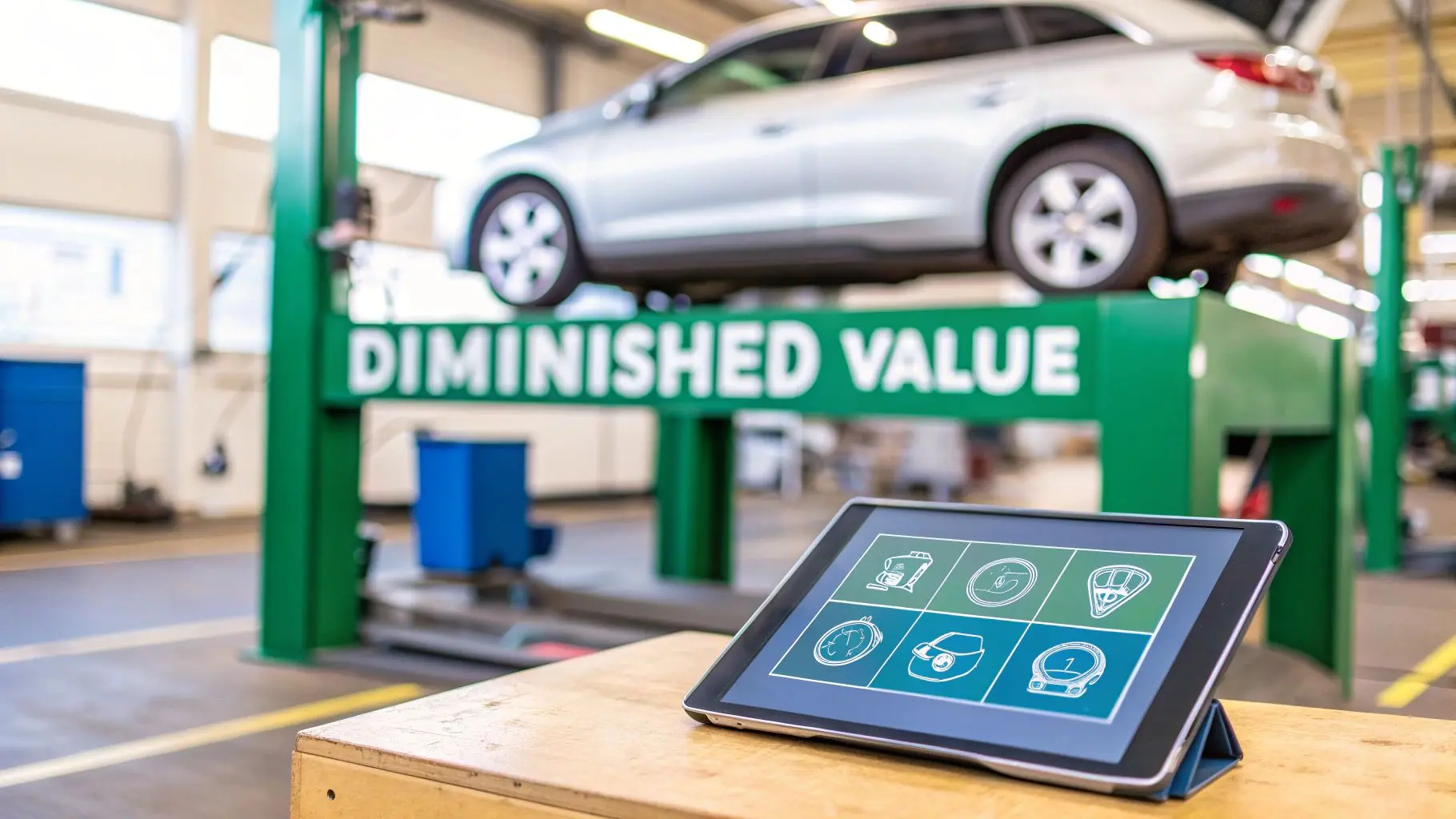After an accident, you know your car isn’t worth what it used to be, even after perfect repairs. Many drivers start searching for a Kelley Blue Book diminished value calculator, but here’s the inside scoop: KBB doesn’t actually offer one. This guide will show you how to use KBB to get a rough estimate and what you need to build a successful diminished value claim.
How to Estimate Diminished Value with Kelley Blue Book
While Kelley Blue Book lacks a dedicated diminished value tool, its standard valuation system gives you a solid starting point. The process boils down to one key factor: the vehicle’s condition rating.
An accident and the resulting repairs will almost always knock your car down from a top-tier rating like “Excellent” or “Very Good” to a lower one, such as “Good” or “Fair.” This drop in condition directly reduces its market value in KBB’s system. By calculating the difference between the two values—before the wreck and after the fix—you can get a ballpark figure for your car’s diminished value.
Why Your Vehicle’s Condition Matters Most
The heart of KBB’s valuation is its condition quiz, which asks specific questions about your vehicle. The system is designed to penalize cars with accident histories, so answering honestly is key.
- Paint and Bodywork: Admitting to “significant paint and/or bodywork” will immediately disqualify your car from the “Excellent” category.
- Structural Integrity: If the accident required frame or unibody repairs, your vehicle will likely be downgraded to “Fair” condition, causing a massive drop in value.
- A Permanent Record: Even if repairs are flawless, you can’t erase the accident history. KBB’s condition ratings are designed to reflect this permanent stain on the vehicle’s record.
A car that has had structural repairs often plummets from “Excellent” to “Good” condition, slashing its market price. This DIY KBB method is a great first step, but it’s only a rough estimate. For more insights into KBB’s valuation process, check out how much will an accident devalue.
Where the KBB Estimate Falls Short
This back-of-the-napkin math is a fantastic way to arm yourself with knowledge, but it is not a formal appraisal.
Insurance companies will almost never accept KBB (Kelley Blue Book) numbers as proof for a diminished value claim. They view KBB as a consumer guide, not an expert valuation service. While your calculation is a powerful tool for your own understanding, it doesn’t carry the official weight needed to win a negotiation with an insurer.
To get the compensation you’re truly owed, you need to back up your claim with a professional, certified appraisal. A SnapClaim report provides the detailed analysis and real-world market evidence needed to build a strong case and push back against an insurer’s inevitable lowball offer.
KBB Estimate vs. a Professional Appraisal
Seeing the difference side-by-side makes it clear. While a KBB (Kelley Blue Book) estimate is a good start, a professional appraisal is what gets claims paid.
| Feature | KBB Calculator Estimate | SnapClaim Professional Appraisal |
|---|---|---|
| Credibility | Consumer-grade estimate | USPAP-compliant, certified report |
| Acceptance | Rarely accepted by insurers for claims | Widely accepted by insurers and courts |
| Methodology | Based on a simple condition quiz | In-depth market analysis of comparable vehicles |
| Detail | A single number with no explanation | Detailed report explaining the valuation |
| Use Case | Personal knowledge and initial estimate | Formal insurance claims and legal negotiations |
Ultimately, a KBB estimate gives you a starting point, but a certified appraisal from a service like SnapClaim provides the proof you need to fight for a fair settlement.
A Real-World KBB Diminished Value Example
Let’s put this into perspective with a real-world scenario.

Imagine you own a popular sedan you’ve kept in immaculate condition. Before a recent accident, it easily passed the Kelley Blue Book condition quiz for an “Excellent” rating. Based on that, KBB estimated its private party value at $21,500.
Then, you get rear-ended. The body shop does a fantastic job with the repairs, which included a new bumper and some minor work on the unibody. The car looks great, but now there’s a catch. When you return to the KBB quiz, you have to be honest and check the box for “repaired unibody damage.” That single detail is a game-changer, immediately knocking your car’s condition rating down to “Fair.”
Calculating the Initial Loss
So, what does that do to the value? You run the numbers again with the “Fair” rating, and KBB’s tool now shows a much lower private party value: $17,300.
The math is simple and jarring:
- Pre-Accident Value (“Excellent”): $21,500
- Post-Repair Value (“Fair”): $17,300
- Estimated Diminished Value: $4,200
Just like that, your car lost $4,200—nearly 20% of its value—from an accident that wasn’t your fault. This number is a fantastic starting point for understanding what’s at stake. To see how experts view these DIY calculations, check out the insights from Diminished Value Claim.
What This KBB Estimate Misses
Here’s the problem: while that $4,200 figure feels significant, it’s not enough to build a solid insurance claim on its own. An insurance adjuster sees a KBB printout as a consumer’s opinion, not as hard evidence. They know it ignores crucial details like:
- The permanent accident history on a CarFax or AutoCheck report.
- The severity of any structural repairs.
- Local market demand for vehicles with an accident history.
For example, the KBB tool doesn’t know if the damage was a minor fender-bender or something serious enough to almost reach the total loss threshold in your state. This is exactly why a certified appraisal is so critical. A SnapClaim report digs deeper, analyzing the actual repair invoice and what comparable cars are selling for in your specific area. That’s how you get the concrete proof needed to successfully negotiate for what you’re owed.
Why Your Insurer’s Calculation Will Be Much Lower
You’ve used a tool like Kelley Blue Book to get a rough idea of your car’s diminished value, and you feel ready to talk to the adjuster. Be prepared: their counteroffer will almost certainly be shockingly low.
Why the huge difference? Insurance companies don’t use consumer tools. They rely on internal formulas specifically designed to minimize claim payouts.
Unpacking the Insurer’s 17c Formula
The most common weapon in their arsenal is the infamous “17c formula.” This is the insurance industry’s go-to method for systematically shrinking your legitimate diminished value claim to a fraction of its actual worth.
The 17c formula starts by taking your car’s pre-accident value and immediately capping the maximum possible loss at just 10%. So if your vehicle was worth $30,000 before the wreck, their calculation starts with a ceiling of only $3,000—no matter how bad the damage was.
From there, it only gets worse. The formula then applies two “multipliers” to slash it even further:
- A Damage Multiplier: A subjective modifier based on the supposed severity of the damage, giving them room to chip away at the value.
- A Mileage Multiplier: This penalizes you for having higher mileage on your car, reducing the payout even more.

These vague multipliers give the insurer all the power to justify a lowball offer, turning your significant financial loss into a payout that feels like pocket change.
A Real-World Lowball Offer
Let’s see how this plays out. Imagine your Hyundai Tucson, with a market value between $26,000 and $28,600, suffered some minor structural damage. The insurance company plugs it into the 17c formula.
After applying their 10% cap and damage multipliers, their internal calculation might land around $650–$715. But what they actually offer you could be as low as $400.
This is the core problem: the 17c formula is not based on real-world market data. It’s an internal calculation designed to protect the insurer’s bottom line, not to make you whole.
This method ignores what a real buyer in your local market would pay for a car with a documented accident history. While a KBB estimate gives you a decent starting point, it won’t hold up against these biased formulas. This is especially true when damage is severe enough to border on a write-off; understanding the details of a total loss appraisal can show you how much value is at stake. To counter their lowball offer, you need a certified appraisal that reflects true market realities.
Turning Your KBB Estimate Into a Winning Claim
You have your Kelley Blue Book estimate. That’s a great first step. But walking into a negotiation with an insurance adjuster armed only with a KBB printout is like bringing a pocketknife to a sword fight. It’s a conversation starter, but it isn’t compelling evidence.
To get the money you’re owed, you need to level up from an online tool to a certified appraisal—something an adjuster can’t just brush aside. This is where a SnapClaim report changes the game, turning your estimate into an ironclad case.
Moving Beyond Simple Condition Ratings
A KBB estimate is built on broad categories like “Good” or “Fair.” An insurance company will attack this, arguing that your rating isn’t based on a detailed analysis of your specific accident. A professional appraisal dismantles that argument with data-driven proof.
- Repair Invoice Analysis: We dig into the body shop’s invoice, line by line, to document the exact nature and severity of the repairs.
- Local Market Data: We pull real-time sales figures for comparable vehicles in your area. This shows what cars like yours—both with and without accident histories—are actually selling for.
- Accident History Impact: Our reports measure the specific dollar amount that a negative mark on your vehicle’s history report (like CarFax or AutoCheck) costs you.
This level of detail is the undeniable proof you need to challenge the insurer’s lowball 17c formula and get a fair settlement.
An adjuster can argue with your opinion of your car’s condition. It’s much harder for them to argue with hard data showing six similar cars in your city sold for an average of $3,500 less simply because they had a documented accident history.
The Power of a USPAP-Compliant Report
SnapClaim appraisals are USPAP-compliant. That stands for the Uniform Standards of Professional Appraisal Practice, the gold standard for valuation recognized by insurance companies, courts, and financial institutions.
When you submit a USPAP-compliant report, it signals to the insurer that you are serious and have credible, third-party evidence to back your claim. It elevates your request from a simple dispute to a formal demand supported by professional documentation. You can get a better sense of the entire process by reviewing our guide on how to file a diminished value claim.
This is the leverage you need to force a real negotiation. And with SnapClaim’s money-back guarantee, you take on zero risk. If your insurance recovery is less than $1,000, we fully refund your appraisal fee.
Strengthen Your Claim With Our Money-Back Guarantee
Going up against an insurance company can feel intimidating, especially when your money is on the line. The thought of paying for a professional appraisal can add to that stress, causing many car owners to wonder if they should even bother fighting for what they’re owed.
We created our guarantee to remove that financial risk from the equation. It’s our promise to you that investing in a professional report is a decision you can make with total confidence.
Our guarantee is simple: if the insurance payout from your diminished value claim is less than $1,000, we fully refund your appraisal fee. No fine print, no loopholes. This policy means you have nothing to lose by arming yourself with the proof needed to demand a fair settlement.
Our Commitment To Your Financial Outcome
We believe every car owner deserves access to professional tools to fight a lowball offer without putting their own money on the line. Our guarantee completely changes the dynamic of your claim:
- Zero Risk: You can order a certified, USPAP-compliant appraisal knowing your investment is fully protected.
- Empowered Negotiation: You gain the confidence to pursue your claim, backed by expert documentation.
- Shared Goal: Our success is tied directly to yours. We’re on the same team, working to get you the best settlement possible.
With SnapClaim, you aren’t just buying a report; you’re getting a partner dedicated to making sure your claim succeeds. Our risk-free guarantee lets you move forward with complete peace of mind.
While a quick estimate from a Kelley Blue Book diminished value calculator is a decent starting point, our certified report provides the serious leverage needed to be taken seriously. For tougher cases, it also helps to learn about the role of diminished value claims attorneys to understand all your options.
Frequently Asked Questions
Navigating a diminished value claim can be confusing. Here are answers to a few common questions.
Can I just show the insurance company my KBB estimate?
While a KBB estimate is a good starting point for your own understanding, insurance companies view it as a consumer guide, not a formal appraisal. They will likely dismiss it as just an opinion. To strengthen your claim, you need professional, third-party documentation from a certified appraiser that analyzes your vehicle’s specific damage and local market data.
Does Kelley Blue Book have an official diminished value calculator?
No, Kelley Blue Book does not offer an official “diminished value calculator.” People create a rough estimate by comparing their car’s value under different condition ratings (e.g., “Excellent” before the accident vs. “Fair” after). This method gives you a ballpark figure but misses critical factors like the permanent stain on your vehicle’s history report. Learn more in our guide on what is a diminished value claim.
What if the at-fault driver’s insurance denies my claim?
Initial denials or very low offers are standard tactics for most insurance companies. Don’t be discouraged. This is where a certified appraisal becomes your most powerful tool. Submitting a professional SnapClaim report signals to the adjuster that you are serious and have the documentation to prove your financial loss, forcing them to negotiate in good faith.
How long do I have to file a diminished value claim?
The deadline, known as the statute of limitations, is different in every state and is a critical detail. Typically, you have between two and five years from the date of the accident to file. It is essential to check the specific laws for your state and begin the process as soon as your car is repaired, or you could lose your right to any compensation.
Ready to fight for the compensation you deserve? SnapClaim provides the certified, data-driven appraisal reports you need to strengthen your claim and negotiate a fair settlement.
About SnapClaim
SnapClaim is dedicated to empowering car owners to recover the true value of their vehicles after an accident. We understand the complexities of diminished value claims and the tactics insurance companies use to minimize payouts. Our mission is to provide clear, data-driven, and professional appraisal reports that give you the leverage needed to negotiate a fair settlement.
Our team of experts utilizes USPAP-compliant methodologies, analyzing repair invoices, local market data, and accident history impacts to deliver a comprehensive valuation. We believe in transparency and fairness, ensuring you have the strongest possible case against lowball offers.
With SnapClaim, you gain a trusted partner committed to your financial outcome. Our industry-leading money-back guarantee means you can pursue your claim with confidence, knowing your investment is protected.




